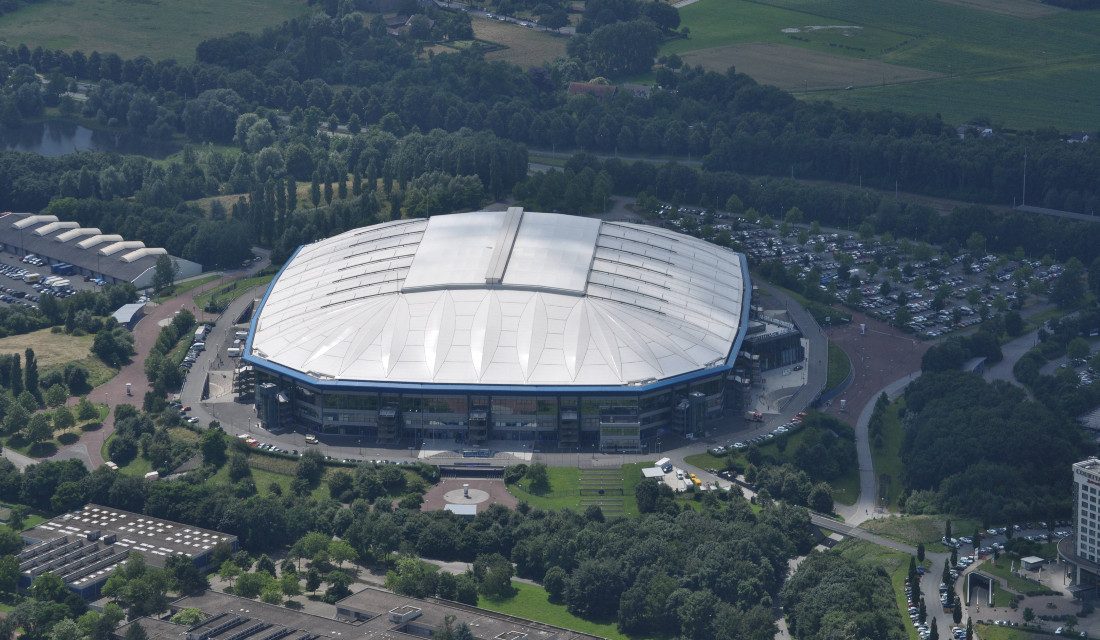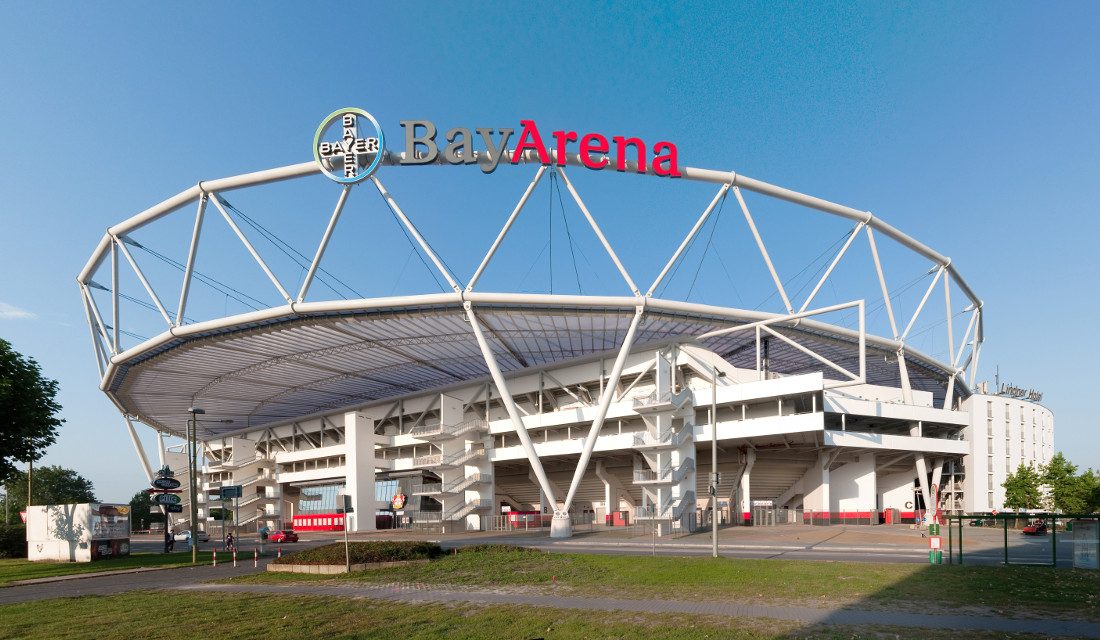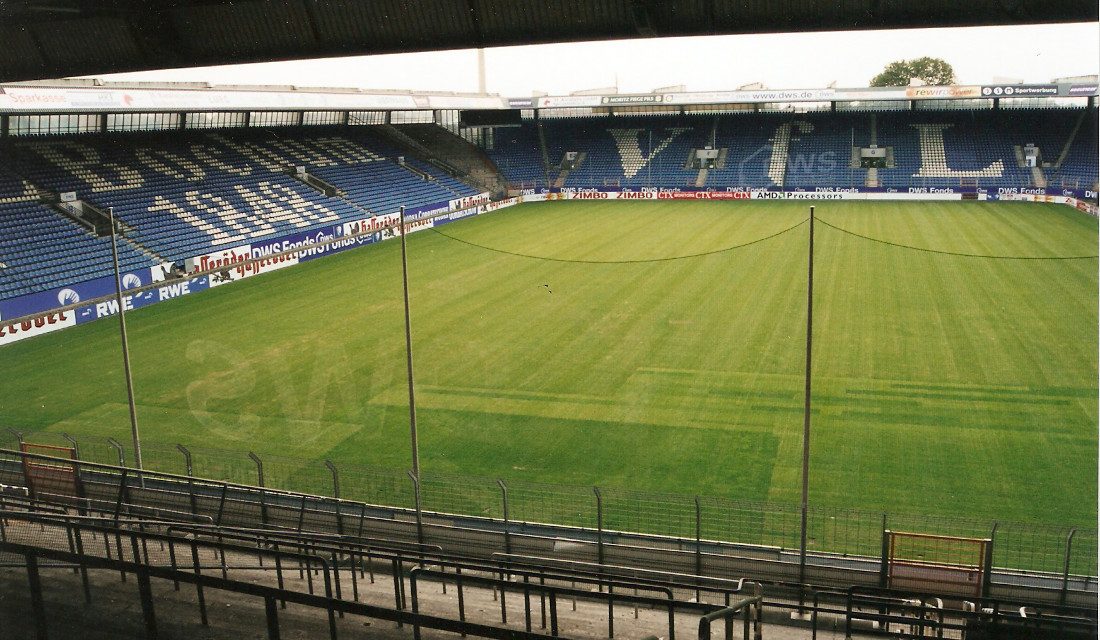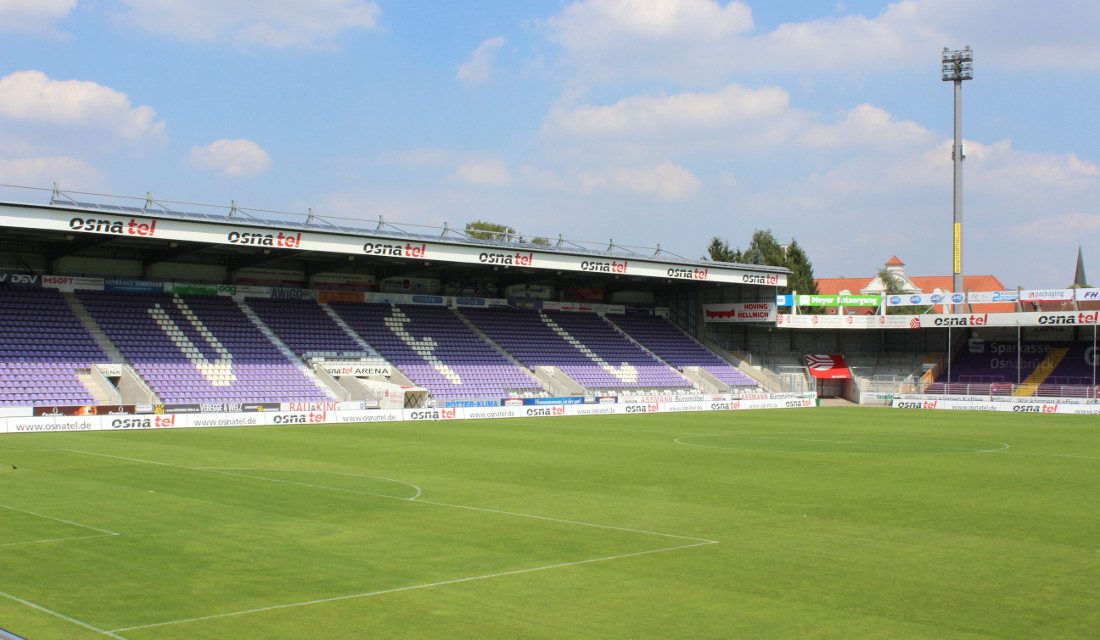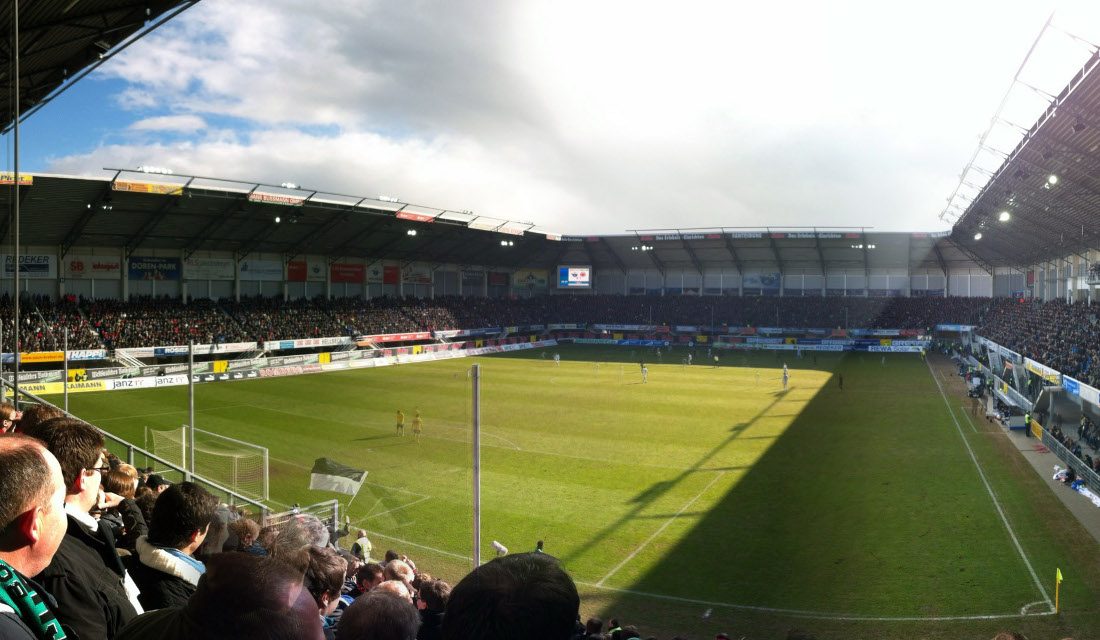Germany’s Ruhr area has traditionally been the land of coal and smokestacks, but is much more these days. Above all though, it’s the home of the Revierderby, Dortmund’s Yellow Wall, some of Germany’s oldest football clubs, and thus a heaven for any football fan.

Ruhrpott Football – in numbers
No. of clubs in the Ruhr Area: 7
No. of clubs in the Rhine-Ruhr area: 15 (7+8)
No. of clubs in wider region: 21 (15+6)
Average stadium capacity: 37,433
Largest stadium: Signal Iduna Park (80,000 seats)
Smallest stadium: Lohrheidestadion (16,233 seats)
Inhabitants Ruhr area: 8.57 million
Inhabitants per club: 1,224,000
Inhabitants per stadium seat: 32
(only includes clubs in Germany’s top four leagues, excluding U23 / reserve sides)
Ruhrpott Football – an introduction
Germany’s Ruhr area, which derives its name from the river Ruhr that runs through it, lies in western Germany not far from the Dutch border. It’s Germany’s industrial heartland, which once had a thriving industry based on coal and steel, but has in recent years made the transformation to a more diversified economy and has gotten a cultural boost.
The main cities of the Ruhr area, in German called Ruhrgebiet but often nicknamed Ruhrpott or Kohlenpott, are Dortmund, Essen, and Duisburg, with each about half a million inhabitants, followed by the likes of Gelsenkirchen, Bochum, and Oberhausen. However, the Ruhr area is pretty much one large city with smaller an larger cities all tied together.
In football terms, the two top dogs in the Ruhr area are undoubtedly Borussia Dortmund and Schalke 04, who together contest the Revier Derby. They’ve got the largest grounds, the biggest support, sell out nearly all games, and are generally playing for the top spots. Of course, the ‘Yellow Wall’ of Dortmund’s Sudkurve is something special in football.
Below the top clubs, VfL Bochum and MSV Duisburg both have a decent following, large stadiums, and had spells of Bundesliga football, though Bochum has been more consistent in the last few decades, while Duisburg has seen more ups and downs.
It is not uncommon in Germany for clubs to have a period of success and then disappear again in the bottoms of the lower leagues. Rot-Weiss Essen, once a Bundesliga winner, has spend most of the last 40 years in the depths of German football, but still remains a club with potential with a new stadium and decent attendances for a Regionalliga team.
While Wattenscheid 09 had a brief spell in the Bundesliga in the early 1990s, the status of the club is definitely lower league, as is the case with Rot-Weiss Oberhausen, who had a short stay in the Bundesliga 20 years earlier. Both clubs still have an old stadium in the shape of a bowl with an athletics track and open terraces behind the goals, which might appeal to a certain football fan, though crowds will generally be limited to a few thousand.
The Ruhr area is easy to get around with multiple forms of transport, and on a well-planned weekend you’ll easily be able to get 3 or even 4 matches in. 2. Bundesliga football generally kicks off on Friday nights with more games Saturday and Sunday early afternoon, while the Bundesliga starts on Saturday at 3:30 pm with more games later in the afternoon and on Sunday. Most 3. Bundesliga matches are on Saturday at 2:00 pm.
However, if you are looking to cram your weekend full of football, you’ll likely have to look further than just the Ruhr area. You won’t have to look far though, as there’s plenty of options close by. These clubs can roughly be divided in three geographical clusters, two of them located in the wider Rhine-Ruhr area, and one more further away in Nordrhein Westfalen state.
The first one is around Dusseldorf, just south of the Ruhr area, and includes the local Fortuna 05, Bundesliga side Borussia Monchengladbach, and the smaller Uerdingen and Wuppertal.
A little further south lies the second cluster around Cologne, which of course includes 1. FC Koln, but also two other small local sides, as well as Bayer Leverkusen just north of the city.
The third cluster is located in the north of the state and includes well-known names as Arminia Bielefeld and Paderborn, and a few smaller clubs. The odd one out is Alemannia Aachen, which lies further west just across the border from The Netherlands and Belgium.
Ruhrpott Football – the stadiums
| Club | Stadium | Capacity | Location |
|---|---|---|---|
| Borussia Dortmund | Signal Iduna Park | 81,359 | Ruhr Area |
| Schalke 04 | VELTINS-Arena | 61,673 | Ruhr Area |
| Fortuna Dusseldorf | ESPRIT Arena | 54,600 | Dusseldorf Area |
| Borussia Monchengladbach | Borussia-Park | 54,010 | Dusseldorf Area |
| FC Koln | RheinEnergieStadion | 50,000 | Cologne Area |
| KFC Uerdingen | Grotenburg-Stadion | 34,500 | Dusseldorf Area |
| Alemannia Aachen | Tivoli | 32,960 | Wider Region |
| MSV Duisburg | Schauinsland-Reisen-Arena | 31,500 | Ruhr Area |
| Bayer Leverkusen | BayArena | 30,000 | Cologne Area |
| VfL Bochum | Vonovia Ruhrstadion | 29,299 | Ruhr Area |
| Arminia Bielefeld | SchucoArena | 26,515 | Wider Region |
| Wuppertaler SV | Stadion am Zoo | 23,067 | Dusseldorf Area |
| Rot-Weiss Oberhausen | Niederrheinstadion | 21,318 | Ruhr Area |
| Rot-Weiss Essen | Stadion Essen | 20,650 | Ruhr Area |
| VfL Osnabruck | Stadion an der Bremer Brucke | 16,667 | Wider Region |
| SG Wattenscheid | Lohrheidestadion | 16,233 | Ruhr Area |
| SC Paderborn | Benteler-Arena | 15,000 | Wider Region |
| Preußen Munster | Preußenstadion | 14,300 | Wider Region |
| Fortuna Koln | Sudstadion | 11,748 | Cologne Area |
| Sportfreunde Lotte | FRIMO Stadion | 10,059 | Wider Region |
| Viktoria Koln | Sportpark Hohenberg | 6,214 | Cologne Area |
Ruhrpott Football – getting around
Finding your way around the Ruhr area may seem confusing at first, but will be easy once you’ve wrapped your head around all the different types of transport.
The Rhine-Ruhr area is considered one transport area, and the website of local transport operator VRR provides a journey planner as well as network maps and timetables. The journey planner from the German railways, Bahn.de, is an alternative, and a requirement for any train journey outside the Rhine-Ruhr area. Of course, journey planners such as Google Maps and the Citymapper app do a similar job.
There are various modes of transport within the Rhina-Ruhr area: regional trains, S-Bahn, U-Bahn, Straßenbahn, and normal urban buses. In particular, the distinction between the middle three can be confusing for foreigners.
In short, regional trains tend to connect the larger train stations within the region. So if you’re looking to go from one hauptbahnhof (main rail station) to another, catching a train tends to be quickest, though they’ll rarely get you directly to a stadium.
The S-Bahn is a commuter rail network, which tends to follow normal rail tracks, but stops at many smaller stations. They don’t have the reach of actual trains, but do run to smaller villages and connect city centres.
The U-Bahn (or Stadtbahn), on the other hand, tends to stay within city limits, connecting the main railway station and city centre with the suburbs. They mostly resemble the metro system as known from other countries, tend to run underground in the city centres, but outside the city centre may feel more like a tram than a proper metro train. The Straßenbahn is even more like an actual tram, but the distinction with the U-Bahn is minor.
Free travel within the Rhine-Ruhr area (all modes of transport) is often included in your match ticket, so make sure to check before you buy your travel tickets to the match. Of course, if it’s one of the larger stadiums, expect a bit of queuing after the match, though extra trains and buses usually make sure that the wait is reasonable.
Airports
The region’s main airport is undoubtedly Dusseldorf International Airport, which is served by many flagship carriers from many European and intercontinental destinations.
Cologne/Bonn Airport is the second-largest airport in the region with service from a mix of flagship carriers and low-cost airlines to mostly European destinations. Dortmund Airport is mostly low-cost focused, while Weeze Airport is a large Ryanair hub.
Dusseldorf and Cologne/Bonn Airport are on the S-Bahn network that brings you quickly into the urban centres, while from Dortmund and Weeze a shuttle bus is needed to get you onto the rail network. Overall, connections are quick though so unless you’re on a super tight schedule, there’s no massive need to pick one airport over another.
Ruhrpott Football – where to stay
The Ruhr area is not known to be one of the most attractive areas, and would figure on few holiday bucket lists, even though it has gone through some regeneration in recent years. Dortmund, Essen, and Duisburg are the largest cities, but while all have a city centre with shopping, some restaurants, and spots of nightlife, none are particularly bustling. Smaller Bochum and its Bermuda3eck will be a better choice if you’re looking for nightlife.
Determining where to stay might therefore largely depend on where you’re attending a match. There are good hotels near Signal Iduna Park, the VELTINS-Arena, and Bochum’s Ruhrstadion, while Duisburg, Essen, and Bochum are all good central bases if you’re looking to attend multiple games around the area.
However, if you’re looking to do more than just watch football, nearby Dusseldorf is the place to stay. It’s got a pleasant old city centre, lots of restaurants and places to drink, and a buzzing nightlife. It’s also got great connections with the rest of the Rhine-Ruhr area.
Cologne, of course, is the real pearl of the region, but is also a bit further away if your main destination are the clubs in the Ruhr area.
Ruhrpott Football – how to get tickets
Top of the list will likely be seeing Dortmund’s yellow wall in real life, but getting tickets for a Dortmund match isn’t easy. Make sure you’re well aware of the on sale date of your match and be ready to buy (online) straightaway when tickets go on sale and you’re in with a chance. If you miss out, the secondary market is an alternative, for example viagogo, though of course you’ll be paying over face value.
Schalke also sell out most games, but, depending somewhat on how well they do in the league, if you buy well in advance it is not too hard to get a few tickets.
Borussia Monchengladback and FC Koln also tend to fill up their stadiums close to sell out, and in successful seasons sell out regularly, but again, if you buy in advance it is not too hard to get tickets. Bayer Leverkusen rarely sell out save for the Bayern home match and the local derbies.
Other clubs rarely sell out save for the odd local derby. However, there’s little reason not to buy your tickets in advance. All of the bigger clubs sell tickets online on easy to navigate websites with print@home facility.
Of course, for most of the smaller clubs you can also just show up on the day and buy your ticket at the stadium. If you’re earlier in the area, tickets are also generally sold in advance at a ticket office or club store at the stadium, while most clubs also sell through a number of sales outlets (vorverkaufstelle) such as tourist information offices, news agents, and sports stores. There’s usually at least one located in the local city centre saving you a trip to the stadium.

